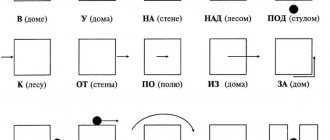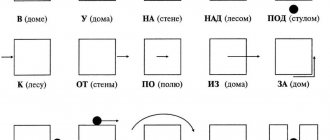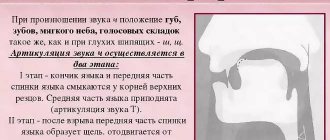- home
- Speech development
Incorrect pronunciation of the sounds “l” and “r” hurts the ears of both adults and children. Timely speech therapy correction - correction of pronunciation in a light playful way, before the child’s self-esteem decreases due to the ridicule of children. Establishing the sound “l” occurs easily and quickly, provided that the problem is identified in a timely manner and parents understand how important the correct articulation of the sound “l” is both for the formation of speech and for the baby’s confidence.
Options for incorrect sound pronunciation
There are several versions of how the letter “l” is distorted when spoken:
- instead of the consonant letter “l”, a vowel is pronounced: “yozhka” - “spoon”, “ypsha” - “noodles”;
- replace “l” with “uva”: “hoteuva” - “wanted”, “euva” - “ate”;
- change to “r”: “rapsha” - “noodles”, “rumble” - “elbow”;
- instead of “l”, when you quickly exhale with puffed out cheeks, you hear “f”, with “n” coming out through the nose.
The child does not pronounce this sound for various reasons. And by the manner of pronunciation, you can understand the reason why it is difficult for him to say “l”, he cannot pronounce the letter.
Introducing the letter E
It is better to start getting acquainted with the letter E by searching for the letter in the large alphabet. If you succeed the first time (preschoolers already know the previous letters), you can move on. Otherwise, you should help the children with a preparatory, simple poem:
We glue the sticks to the line: One, two, three... and the letter E. The letter E will remind us of the three-pronged comb. (Rein S.)
After listening to such a description, the children will easily find the letter E. It will be good if the children learn this poem by heart in order to better remember and pronounce the desired sound once again. For greater effect, combine repeating the poem with watching an interactive video.
The next stage of learning is to look at a sample of writing a letter. You can write down the desired symbol individually with each child or on the board for the whole group (this is how we teach children independence).
The letter has been studied, children can already distinguish it from others. The next task is to explain to them that E is spelled differently. The simplest and most proven way of explanation is the example of a family, where the large printed E is the father (the head of the family), the large capital E is the mother, and the small “e” is their child.
Causes of impaired pronunciation of the sound l
There are several reasons when the pronunciation of “l” is not formed or is broken:
- The baby has not yet learned to say this sound and he simply skips it: for example, “even” instead of “rain.” At the age of 4-5 years, children have already mastered it, and by the age of 6, the child can no longer just talk, but can already differentiate a hard sound from a soft one;
- interdental pronunciation is characterized by incorrect positioning of the tongue, although acoustically it appears clearly;
- bilabial pronunciation: the tongue lies on the “bottom”, which is characteristic of the sound of the English language. This happens when a child has to communicate in several languages in the family;
- a mobile lower lip and a relaxed tongue - it turns out “v” instead of “l”: “development” - “fork”;
In these cases, articulation disorders are explained by an incorrect pronunciation algorithm, namely, the position of the tongue is not formed. There are also violations when differentiation is impaired due to improper breathing, incorrect position of the tip of the tongue, its middle:
- sound formation occurs through the lips, not the tongue;
- the tip of the tongue goes down instead of resting on the incisors;
- the middle of the tongue is raised, and the tip of the tongue is lowered, but the opposite is necessary.
The described disorders are due to the characteristics of the articulatory apparatus. In these cases, automating the correct sound l will take literally a couple of sessions with a speech therapist. You can also quickly deal with this at home. If sounds are produced for dysarthria associated with organic, functional disorders of the central nervous system, a step-by-step systemic production and automation of the sound l is necessary.
Sound correction [l] at home
Speech disorders occur for various reasons. In the case where the child does not speak only one or two sounds, parents can try to correct the defect themselves.
Classes with a speech therapist will help correct any speech problems
How to teach a child to say the letter L hard
With dyslalia, children have problems only with sound pronunciation. Violations arise due to structural features of the articulatory apparatus or insufficient muscle preparation.
For the sound [l], the upper rise of the tip of the tongue is important. This is difficult to do with a short hyoid frenulum. Therefore, it must first be trimmed by a dentist. Only surgery will solve this problem.
It’s easy to check the ligament: you need to ask the child to touch the upper teeth with the tip of his tongue. Sonoras ([l], [r] and their soft pairs) appear by the age of five and until that time there is nothing to worry about. At three years old, the child’s articulatory apparatus is still developing.
Important! There is no need to rush and demand that children pronounce all sounds from an early age. Otherwise, you can provoke the development of a defect.
At home, you can try to correct the incorrect pronunciation of the sound [l] yourself. This is only allowed in the case of dyslalia. Sometimes this problem can be confused with dysarthria, which requires work with a speech therapist.
With dysarthria, the mobility of the muscles of the articulatory apparatus is impaired. A similar problem is expressed in hypertonicity or hypotonicity. Often the tongue of such a child is bunched up in the mouth or is too relaxed. It will be difficult for your baby to perform fine movements and switch from one position to another.
Correcting incorrect pronunciation may take up to one year. You need to work with your child every day - this will speed up the process. It is necessary to follow the sequence of stages and not rush.
Sound production
The mechanical method is often used in speech therapy. It requires a special probe in the form of a wire frame or a spatula. The child opens his mouth wide, pronounces “YYYYYY” in a drawn-out manner, and at this time the adult lifts his tongue with an instrument.
It is easier to teach a child to pronounce a sound from the interdental position. To do this, the preschooler is asked to bite the tip of the tongue and pronounce the sound [s] (YYYYYYY), and then gradually remove the tongue behind the upper teeth.
You can pronounce [l] in the interdental position immediately with syllables. Gradually we are moving away from this situation. Automation begins only with direct syllables: LA, LO, LY, LE.
Important! You cannot rush to move on to words, otherwise defective pronunciation will become entrenched.
Speech development in older preschoolers through play activities
Sound Automation
After the correct pronunciation has been worked out in forward and backward syllables, they move on to words. To facilitate perception, visual material is used in the form of pictures and special games. For example, a child is asked to show objects with the sound [l].
Syllables can be pronounced using a probe
It is difficult to teach a preschooler to exercise self-control. Therefore, you need to constantly work with him. It is enough to devote less than half an hour to work and the effect will not be long in coming.
Parents should understand that there is no method that will give quick results. Only constant training will help you consolidate correct pronunciation.
Songs and rhymes
To facilitate the automation process, different lexical material is used. Pure sayings and poetic forms are easier to remember and the child likes to reproduce them.
You can talk to a preschooler about different topics. This will make it easier for him to get used to the correct pronunciation.
Example of poems for sound automation [l]
The main condition for effective classes is the interest of the student. Therefore, everything is carried out in a playful way. The more varied the material, the better for the baby.
Tongue Twisters
The most difficult thing is to introduce sound into independent speech. To facilitate the process, tongue twisters using the sound [L] are used. They contain words that allow you to practice sound pronunciation in different positions.
For example, “There are pins at the Christmas tree”, “Will in the field”, “I went to Luka’s tray, Luka bought onions from the tray”, etc. Gradually, the child is asked to pronounce each tongue twister faster. Much attention is paid to correct pronunciation.
Articulation exercises
Learning to pronounce a sound correctly begins with articulatory gymnastics. Speech therapy exercises for quickly setting sound [l]:
- The wide tongue lies behind the lower teeth, the child pronounces “YYYYYYYY” in a drawn-out manner.
- Lick your upper lip with the tip of your tongue.
- Click your tongue.
- Open your mouth wide and run your tongue along the inside of your teeth.
- Run the tip of your tongue across the roof of your mouth.
The complex is performed every day. In order for a child to learn to pronounce a sound correctly, he must do all the exercises correctly. In this case, it is important to monitor the immobility of the jaw.
Articulation gymnastics is performed strictly in front of a mirror
After all the movements are easy to perform, move on to the next stage - producing a solid sound [l]. To do this, different techniques are used. It is impossible to say in advance which one will suit a particular child.
Setting the sound l
Before starting classes, the child must be explained in detail and shown how to pronounce the sound correctly. In this case, a speech therapist or parent must show the child how the articulatory apparatus should work correctly; visual materials can also be used.
Articulation of the sound l
Correct articulation of the sound l: the sharp tongue is raised by the upper teeth, resting on the alvioles (tubercles on the palate located behind the upper teeth). The shape of the tongue in this case resembles a saddle, the air comes out along the edges of the tongue.
Articulation gymnastics for the sound l
There are several ways to produce the sound l, among which the first place is occupied by articulatory gymnastics for forming the sound l. The child will like it due to the fun articular exercises:
- blow soap bubbles, blow on candles, boats on the water;
- “boat”: a relaxed wide tongue should be placed on the lower lip and try to form a boat out of it without lifting it;
- “snake”: stretch your lips, as if in a smile, and extend your sharp, hard tongue forward;
- “the longest tongue”: stick it out as far as possible and try to reach either the chin, the tip of the nose, or the cheeks;
- “horse”: open your mouth, touch your tongue between the upper incisors and tap there so that you get the clatter of horse hooves;
- “turkey”: open your mouth, relax your lips and use your tongue to stroke your upper lip with your tongue moving from top to bottom, saying “bl.”
There are many videos on how to do these exercises to prepare for the sound L. Classes for preschoolers are held in a relaxed atmosphere 1-2 times a day.
A complex of articulatory gymnastics for the sound L in pictures and verses
Automation of sound L
Before you start teaching your child to pronounce the letter L, it is necessary to warm up with articulatory gymnastics. This will prepare the speech apparatus for work, tones the tongue, lips and cheeks. In essence, gymnastics are speech therapy exercises for producing isolated sound.
We offer a summary of lessons on automating the sound L in syllables and sentences, which will help mothers organize this process at home. Also, riddles about the letter L stimulate isolated sound pronunciation, since the answer is L itself. As soon as the child has learned to pronounce L in isolation, move on to automating the sound L in straight syllables.
If the child does not yet read on his own, first pronounce it yourself, and then offer the child:
And after mastering, in reverse syllables:
The next stage is the automation of L in words. The following sequence must be followed:
- sound at the end of a word: floor, hall, corner, channel, knocked, pinched;
- sound in the middle of a word: wolf, push, pity, jackdaw, violet, volcano, hairpin, mower;
- the sound is paired with consonants: flag, club, flame, block, flag, globe, planet, notepad;
- one word contains 2 sounds: swam, weeded, climbed, broke, swallowed, cried, threshed, bell.
In order to put a sound in words and phrases, you must first master hard pronunciation, because when softening it is harder to pronounce the sound.
After mastering L in words, they master sound in phrases and sentences:
ripe strawberries, a tin soldier, a broken saw;
conjugate sentences by first speaking phrases in the first person, then in the plural person and in the third person: “I broke the bike - We broke the bike - She broke the bike.”
read/repeat more complex sentences.
Then we read and learn poems starting with the letter L. In special poems, sound occurs in almost every word.
When reading and repeating rhymes, you should pronounce the words measuredly, slowly, so that the child pronounces the sound clearly. It is necessary to speed up speech in tongue twisters and riddles. For example, “Here is a cheerful bun rolling like a ball.” Or “Polkan pushed the stick with his paw.”
The feasibility of speech therapy classes
Some parents do not think about how to teach their child to say the letter L. They do not consider the defect to be something serious, but in adult life it will become the basis of complexes and worries.
Important! It is better to correct speech disorders in preschool age, then the process will take a little time.
Speech therapy exercises for speech development in children from 3 to 4 years old
If parents do not know how to correctly teach their child to pronounce the letters L and R, then they should contact a specialist. A speech therapist will be able to correct this problem and develop the desired pronunciation.
How many lessons does it take to produce sound [l]
It is impossible to say with certainty how many lessons will be required to eliminate the defect. Sometimes sound production takes one session, in other situations it will take more than 30-40 meetings.
It all depends on the characteristics of the child, his motivation and the interest of the parents. Learning to pronounce the sound [l] is not so easy, since a preschooler gets used to a certain stereotype. Due to their age, it is still difficult for children to perceive learning activities.
How does an individual sound production lesson work [l]
The speech therapist performs sound production only after the student performs articulatory gymnastics well. The complex is performed strictly in front of a mirror. Afterwards they do breathing exercises and perform speech hearing tasks.
How does an individual lesson on sound automation work [l]
The speech therapist conducts individual lessons on automating the sound [l] only after calling an isolated pronunciation. At such lessons, the specialist develops the lexical and grammatical structure of speech, phonetic and phonemic hearing.
To do this, use different games and simulators. Modern speech therapists use computer games. Parents are required to participate in the process and carry out the specialist’s tasks at home.
Important! The duration of the lesson for preschool age is approximately 25 minutes. Physical minutes are required to switch activities.
Games to strengthen pronunciation
The game form of speech therapy classes allows you to awaken the child’s interest and get carried away by the process. Here are examples of games to reinforce the pronunciation of L:
- “Tracks”: a large letter L is written on a piece of paper and wavy paths from it to objects that begin with this sound. The child needs to place his finger on the letter and lead along a line from it, pronouncing the sound all the time, and at the end name the object.
- “Koloboks”: you need to make a figurine of a fox and 10 koloboks, as well as pictures with words containing the letter L in different parts of the word. If the baby correctly names the word from the picture and clearly pronounces the sound L, then the bun runs away from the fox; if not, she eats it.
- “Object pictures”: prepare pictures with words from l and ask the child to name the image and then find the required object. For example: show me the chair, show me the apple.





![Producing the sound [L] to a child in stages. Articulation gymnastics, speech therapy exercises, pronunciation lessons with pictures](https://doktorobrubov.ru/wp-content/uploads/postanovka-zvuka-l-rebenku-poetapno-artikulyacionnaya-gimnastika-logopedicheskie-uprazhneniya-uroki-330x140.jpg)




